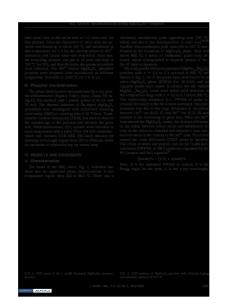Novel red-emitting Na 2 Mg(PO 4 )F:Eu 3+ phosphors with abnormally high intensity of 5 D 0 - 7 F 4 transition
- PDF / 2,598,182 Bytes
- 11 Pages / 595.276 x 790.866 pts Page_size
- 42 Downloads / 240 Views
Novel red-emitting Na2Mg(PO4)F:Eu3+ phosphors with abnormally high intensity of 5D0-7F4 transition Xiao Gao3, Bin Deng1,2,*, Chong-song Zhou1,2, Fan-hua Zeng1,2, Hui Liu1,2, Jin Zhao4, and Ruijin Yu3,* 1
College of Chemical Biological and Environmental Engineering, Xiangnan University, Chenzhou 423043, Hunan, People’s Republic of China 2 Hunan Provincial Key Laboratory of Xiangnan Rare-Precious Metals Compounds Research and Application, Chenzhou 423043, Hunan, People’s Republic of China 3 College of Chemistry & Pharmacy, Northwest A&F University, Yangling 712100, Shaanxi, People’s Republic of China 4 College of Science, Xi’an University of Architecture and Technology, Xi’an 710055, Shaanxi, People’s Republic of China
Received: 21 June 2020
ABSTRACT
Accepted: 4 November 2020
Novel single-phase red-emitting Na2Mg(PO4)F:Eu3? phosphors are successfully synthesized in this work. The phase structure, surface morphology, and particle size are obtained. The photoluminescence excitation (PLE) spectrum, photoluminescence emission (PL) spectra, thermal quenching, and lifetime are also measured. The PLE spectrum exhibits a strong excitation peak at 395 nm, which matches the near-ultraviolet InGaN chip. The PL spectrum possesses a series of peaks associated with 5D0?7FJ (J = 0–4) transition of Eu3?. The abnormal high emission peak located at 700 nm is due to the 5D0?7F4 transition, which is different from most Eu3?-doped phosphors. The optimum doping concentration (x) is 10% mol, and the quenching temperature (T0.5) is over 470 K. The lifetimes of the prepared phosphors are in the range of milliseconds. The Commission International de I’Eclairage (CIE, 1931) coordinates were measured to be (0.621, 0.377). The white light-emitting diodes (w-LEDs) are also fabricated by the prepared phosphors and commercial phosphors. The above results indicate that the Na2Mg(PO4)F:Eu3? fluorophosphate phosphors can be applied for w-LEDs.
Published online: 16 November 2020
Ó
Springer Science+Business
Media, LLC, part of Springer Nature 2020
1 Introduction In recent years, white light-emitting diodes (w-LEDs) have attracted enormous interests from scientific research and civilian use as the next-generation
lighting source due to its energy conservation, environmental protection, long lifetime, and stable performance [1–7]. The current devices in the lighting market almost have been replaced by w-LEDs [8, 9]. At present, w-LEDs are mainly obtained by
Xiao Gao and Bin Deng have contributed equally to thiswork.
Address correspondence to E-mail: [email protected]; [email protected]
https://doi.org/10.1007/s10854-020-04833-2
23053
J Mater Sci: Mater Electron (2020) 31:23052–23062
phosphor-converted technology [10, 11]. Thus far, the most frequently used method, which is considered the most common and practical, is the combination of the blue LED chips and yellow-emitting phosphor Y3Al5O12:Ce3? (YAG:Ce3?) [12]. Nevertheless, this approach has some clear disadvantages, such as low Ra (Ra \ 80) and high correlated color temperature (
Data Loading...









